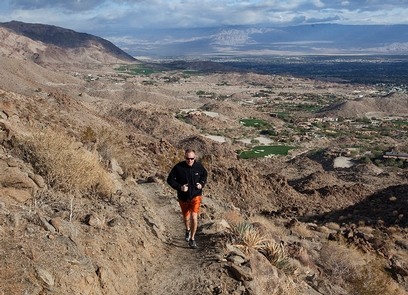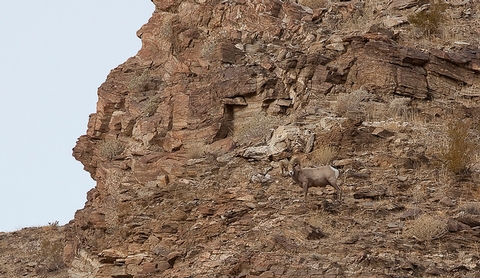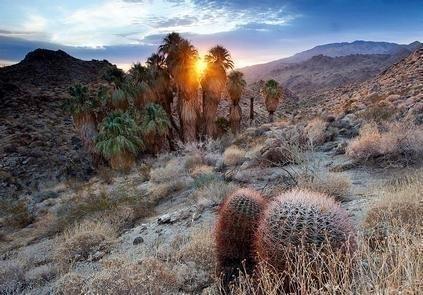Santa Rosa and San Jacinto Mountains National Monument
The Santa Rosa and San Jacinto Mountains provide a world-renowned scenic backdrop to the desert communities of the Coachella Valley. The National Monument serves as a model for community based support and creation. This monument reflects the vision of the local jurisdictions that assisted in the designation.

Safety
Many areas of the Santa Rosa and San Jacinto Mountains National Monument are remote and challenging. You cannot always depend on a signpost or a ranger to get you out of a fix. Bring appropriate equipment so you can be prepared for weather changes and can take care of yourself, if necessary, overnight.
- Do not recreate alone. Or leave an activity plan with friends, family, or a ranger that detail where you will be and when you expect to return.
- Have a communication plan. Cellphones do not get signal in all parts on the National Monument; a radio, personal locator beacon, satellite phone, or signaling mirror can be crucial in a time of need.
- Carry and drink as much water as you can. At least one gallon per person per day is recommended. When half of your water is gone, turn around and head back.
- Protect yourself from the sun. Dress in layers, Wear a hat, sunglasses, protective clothing, and sturdy footwear. Use sunscreen. Bring warm layers and a waterproof shell on longer hikes – the weather can change quickly.
- Know your trail. Carry a map and pay attention to the terrain so you can find your way back.
- Beware of dangerous flora and fauna. Watch where you put your hands and feet. Cacti, ocotillo, rattlesnakes, and bees (to name a few) may pose danger to visitors.
- Keep children near you and stay on the trail.
Recreation
To help you decide which of the many trails to take – especially if you’re a newcomer – we have divided the National Monument into three areas: the San Jacinto Mountains west of Palm Canyon divide, the Northern Santa Rosa Mountains between the Palm Canyon divide and Highway 74, and the Southern Santa Rosa Mountains from Highway 74 to the Monument’s border with Anza Borrego Desert State Park. Each area has its own personality. Along with the trail areas listed above, these are some of the more popular trails in the Santa Rosa and San Jacinto Mountains National Monument.
Trails are rated as easy, moderate, or strenuous in accordance with the following criteria*:
- Easy – Generally a leisurely walk, but don’t expect the trail to be flat.
- Moderate – A serious hike, but not difficult for those in reasonably good condition.
- Strenuous – Some trail segments require being in very good condition and/or the trail is long and requires stamina.
*Difficulty ratings are based on one-way trips. When assessing how difficult a trail may be for you, consider whether you plan to return on the same trail, thereby doubling your distance, or by using another trail which also adds mileage and difficulty. Be aware that using two moderate trails to complete a loop may result in a strenuous hike.
The best time of year for enjoying lower elevation trails is November through April; for higher elevation trails, the best time is May through October.
Many trails are open to all forms of non-motorized travel – hiking, horseback riding, and mountain biking – but not all trails are open to everyone. Mountain bikers are prohibited in designated wilderness areas, in the Indian Canyons, on certain trails near Murray Hill, or on any part of the Pacific Crest Trail. Check with the appropriate agency if you don’t know the rules.
Be safe and enjoy!

Dogs at the Monument
Dogs are not allowed on most trails in the National Monument. At lower elevations, this prohibition is enforced for the protection of endangered Peninsular bighorn sheep, which react to dogs as they would to coyotes, a natural predator. In the San Jacinto Mountains, which are usually accessed via the Palm Springs Aerial Tramway or from the alpine community of Idyllwild, dogs are prohibited in Mount San Jacinto State Park and Wilderness. Dogs are also prohibited in the Indian Canyons.
Photos
Accessibility Description (ABA/ADA)
View images of accessibility features in a new window.
National Monument:
Hiking trails in the Monument were not designed to be accessible.
Visitor Center:
There are 2 paved parking lots for the Visitor Center with a total of 52 parking spaces. Each lot has at least 2 accessible spots that are painted and signed. The upper parking lot is next to the Center. A paved portion of the Randall Henderson Trail leads to the lower parking lot. Cell phone reception is spotty.
Two accessible flush toilets are attached to the exterior of the Visitor Center facility. They are closed when the Center is closed. An accessible drinking fountain and bottle-refilling station is available 24/7 outside.
There are several picnic areas around the Visitor Center, including a covered patio with 1 picnic table that can accommodate wheelchair users.
Inside the Center, half of the space is dedicated to a gift shop. The other half has rotating interpretive exhibits focusing on the geology and ecology of the Monument. The information desk and counters are low, easily accessed by visitors using wheelchairs or other mobility devices.
The Ed Hastey Garden Trail is an accessible concrete path that leads to outdoor exhibits and interpretive sites located around the Center. The Trail takes visitors through an educational garden with an emphasis on Colorado Desert native plants and wildlife. The plant ID tags in the garden and the Center’s welcome signs are in English, Spanish, and Cahuilla.
Public presentations, accessible tours led by birding groups, and activities promoting accessible recreation are offered regularly at the Center.
Note: Descriptions and photos uploaded March 2025. Please note that actual on-the-ground conditions may vary due to natural events (e.g., weather, wildfires, erosion), normal wear and tear, or site improvements.
FEES IN THE NATIONAL MONUMENT
Most Federally managed sites in the Santa Rosa and San Jacinto Mountains National Monument do not require fees. However, the USFS operates two fee-site campgrounds in the Pinyon Flat/Cactus Spring area: Pinyon Flat Campground and Ribbonwood Equestrian Campground.
Pinyon Flat Campground provides 18 first-come, first-served sites, with potable water and toilets available for $8 per night.
Ribbonwood Equestrian Campground provides potable water, toilets, showers, and two horse corrals per site. Sites are available for $15 per night. This campground is by reservation only, the USFS stipulates that reservations must be made at least 3 days in advance of your desired visit. Reservations should be made through the recreation.gov Ribbonwood Equestrian Campground webpage.
Other sites managed by non-federal entities, such as the Indian Canyons, Palm Springs Aerial Tramway, or Living Desert (to name a few) do require fees. Check with the appropriate agency prior to your visit for the most current fee information.
UPCOMING EVENTS
Geographic Coordinates
Directions
The Santa Rosa Mountains Visitor Center located off State Highway 74 south of Palm Desert was dedicated in 1996 and open to the public. The Visitor Center address is 51-500 Hwy 74, Palm Desert, CA 92260 and is 4 miles south of the intersection of Highway 74 and Highway 111 in Palm Desert.






